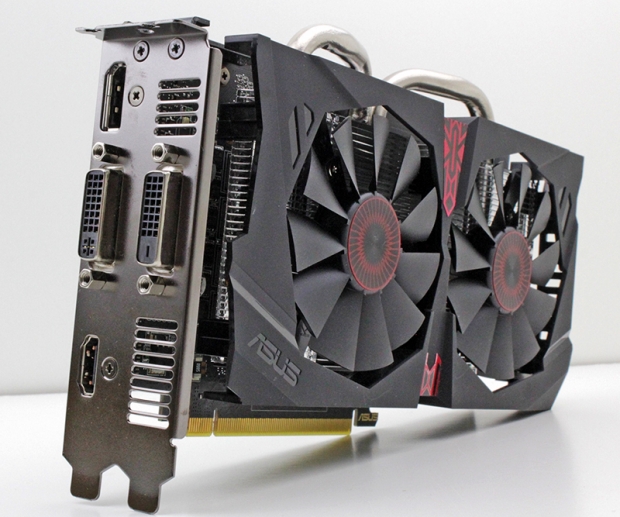Index
Review: Compact and extremely quiet during gaming
Many parameters for this entry-level to mainstream graphics card are well tuned, but the price is too high.
Nvidia recently launched its newest Geforce 900 series graphics card, the GM206-based, US $159.99 priced Geforce GTX 950. Today we will take a closer look at a factory overclocked GTX 950 made by ASUS.
Our test sample is the GTX 950 Strix (part number 90YV08V0-M0NM00) and it comes with the company’s trademark DIRECTCU II dual-fan cooler. Its factory overclock sets the GPU Base clock to 1140MHz (1165MHz OC mode) and boost clock to 1355MHz. Reference clocks are 1024MHz (Base ) and 1188MHz (Boost).The factory overclock is not highest among GTX 950 cards from other Nvidia partners, but the ASUS Strix provides great overclocking potential.
The Geforce GTX 950 is Nvidia’s second mainstream graphics card based on the new second generation Maxwell architecture. Maxwell has a great combination of performance, power-draw, and low fan-noise, and it comes with DirectX 12 support.
The Maxwell SM was rebalanced to give each processing block of CUDA cores its own dedicated resources for instruction scheduling and dispatch. This keeps the GPU’s CUDA cores fully used more often, improving workload efficiency and reducing wasted power.
The GTX 950 graphics card is based on silicon codenamed GM206. This GPU is used for the GTX 960 graphics card, but Nvidia has disabled some parts of the GPU to create the GTX 950.
Nvidia markets the Geforce GTX 950 as a card for MOBA (multiplayer online battle arena) gaming with a 60FPS. It is supposed to be super responsive with a low latency and provide DirectX 12 and MFAA support.
It will run other game genres at 1080p, including the Witcher 3 : Wild hunt, GTA V, Battlefield: Hardline, Call of Duty: Advanced Warfare and FarCry 4.
Nvidia describes the Geforce GTX 960 as a “sweet spot” graphics card. Traditionally Nvidia’s “sweet spot” cards are 60-series models such as the GTX 460, 560, 660, and 760. They offer a good price/performance ratio and the current generation can run most titles at 1080p with high detail settings.
The GTX 950 is made for gamers on budget and it comes with 25 per cent less shaders compared to the GTX 960. For a good framerate in games at 1920x1080 resolution some graphics details must be lowered. In the updated Nvidia’s Geforce GTX lineup the GTX 960 is positioned below GTX 960 but above the aging GTX 750 Ti graphics card based on the first generation Maxwell GM107 GPU.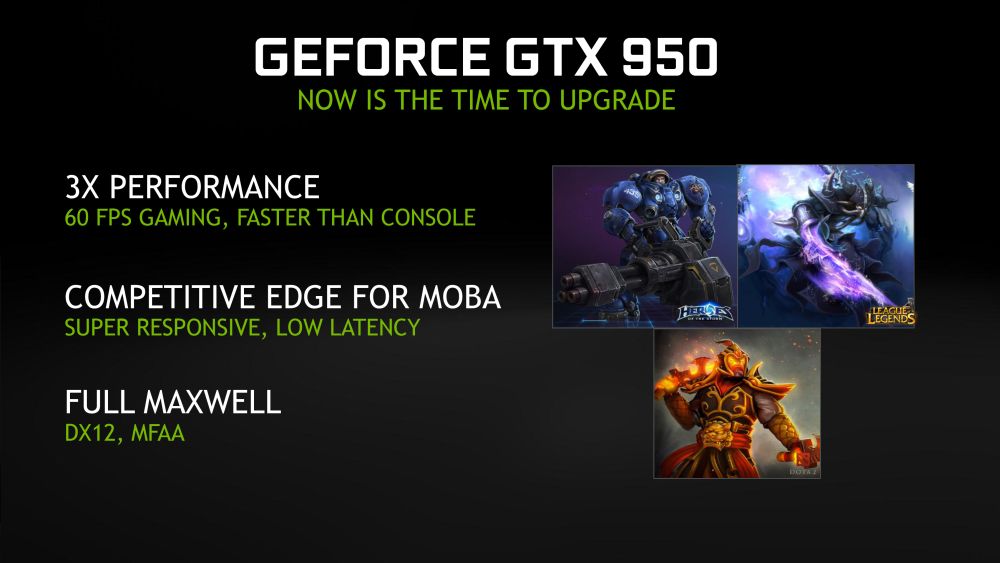
The GTX 950GPU Base clock for the is set at 1024MHz compared with 1127MHz on the GTX 960. The memory clock for the GTX 950 is set at 1650MHz (6600MHz effective GDDR5) while memory on the GTX 960 works at 1750MHz (7000MHz effective GDDR5). Resulting bandwidths are 105.6 GB/s and 112 GB/s respectively.
The next image shows the ASUS GTX 950 Strix OC graphics card which manages to provide both good performance and silent work. Strix uses custom PCB with 220mm length.

Unlike the GTX 960, where GM206 GPU was running with 8 SMMs, for a total of 1024 CUDA cores, 64 Texture Units and 32 ROPs, the GM206 behind the Geforce GTX 950 has been cut-down to 6 SMMs. This gives a total of 768 CUDA cores, 48 Texture Units and 32 ROPs. The GM206 on the GTX 950 is paired up with 2GB of GDDR5 memory running on a 128-bit memory interface. ASUS did not change the memory clock. The GPUZ screenshot below confirms the clocks.
The typical boost clock speed is 1355MHz. The boost clock speed is based on the average Geforce GTX 950 card running a wide variety of games and applications. Note the boost clock will vary from game-to-game depending on system conditions.
With the arrival of the Geforce GTX 950, Nvidia’s Geforce GTX lineup consists of the following GPUs:
- GeForce GTX TITAN X
- GeForce GTX 980 Ti
- GeForce GTX 980
- GeForce GTX 970
- GeForce GTX 960
- GeForce GTX 950
- GeForce GTX 750 Ti
The GM206 Pro GPU
The GM206 GPU used in the Geforce GTX 960/ GTX 950 features all the key architectural innovations first introduced in the Geforce GTX 980. Maxwell GPUs feature a new SM design that’s been tailored to improve efficiency.
The Maxwell SMM is partitioned into four distinct 32-CUDA core processing blocks (128 CUDA cores total per SMM), each with its own dedicated resources for scheduling and instruction buffering. By giving each processing block its own dedicated resources for instruction scheduling and dispatch, Nvidia fully uses the GPU’s CUDA cores more often. This improves workload efficiency and reduces power that usually goes to waste.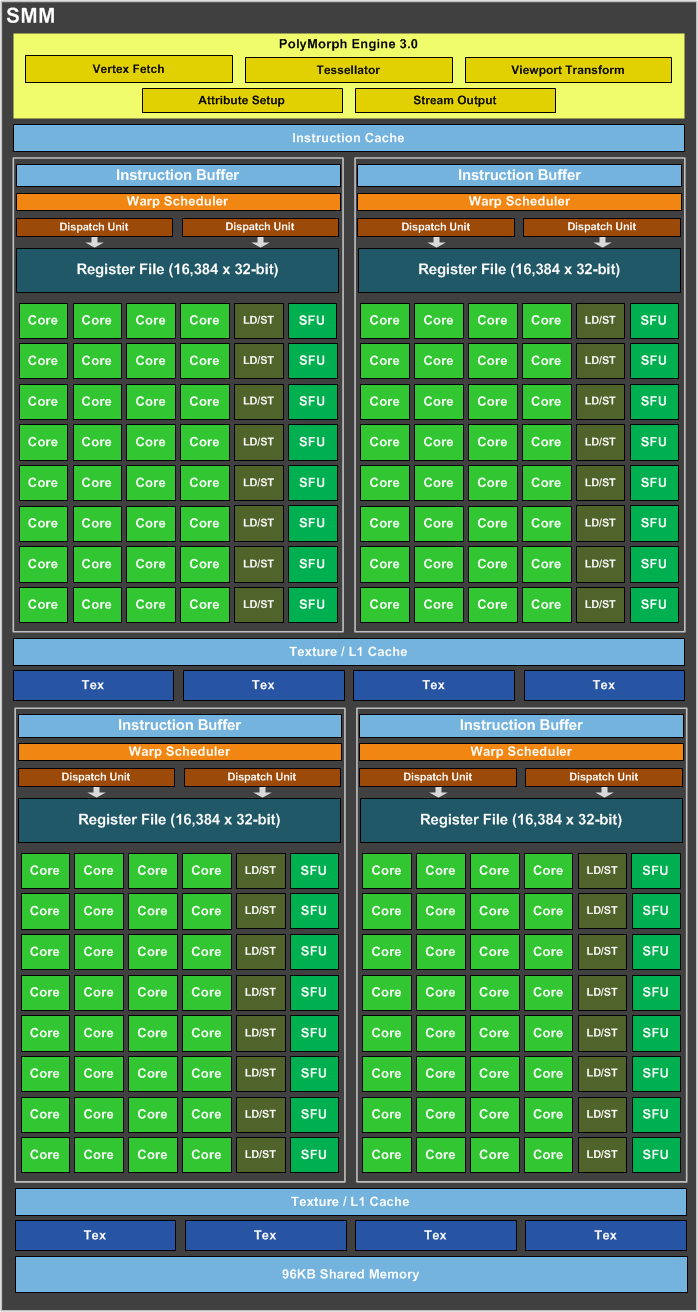
The GM206 GPU used in the Geforce GTX 950 ships with six SMM units and is composed of 768 CUDA cores in total, while 48 texture units are available for texture processing (compared to 1024 CUDA cores in GTX 960).
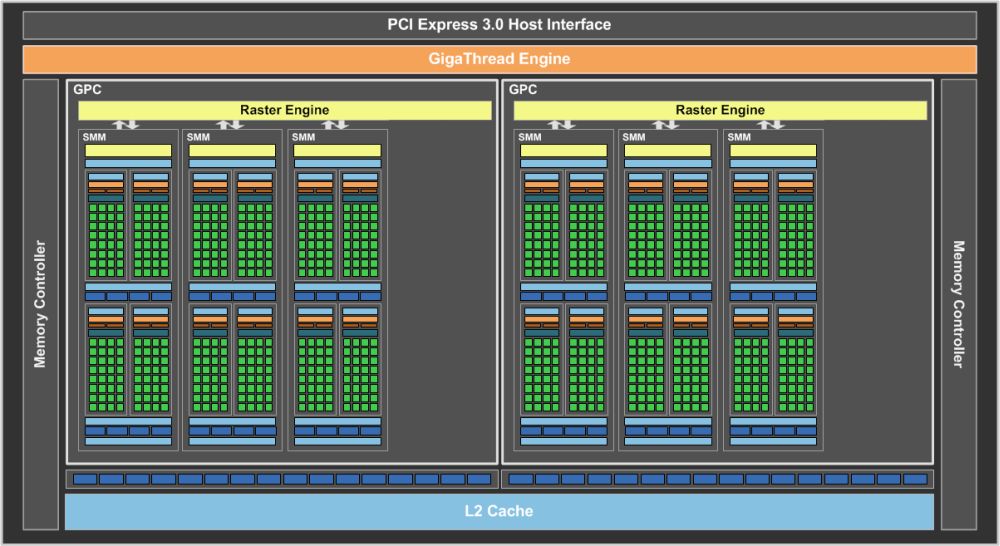
To improve the efficiency of the GPU’s onboard caches, Nvidia has made several changes to Maxwell the cache hierarchy.
Each of GM206’s SMM units features its own dedicated 96KB shared memory, while the L1/texture caching functions are combined into a 24KB pool of memory per pair of processing blocks (48KB per SMM).
Previous generation Kepler GPUs had a smaller 64KB shared memory function that was shared as L1 cache.
GM206 ships with 1MB of L2 cache that’s shared across the GPU. With more built-in cache, fewer requests to graphics DRAM are needed, this improves performance and reduces power consumption.
Nvidia’s third-generation delta colour compression engine offers new modes for colour compression, allowing the GPU to more effectively use its available memory bandwidth. The GM206 uses roughly 25 per cent fewer bytes per frame compared to older generation Kepler GPUs.
Because of these changes, each GM206 CUDA core can deliver roughly 1.4x more performance per core compared to a GK106 Kepler CUDA core (the direct predecessor of GM206), and 2x the performance per watt.
The memory subsystem of Geforce GTX 950/ GTX 960 consists of two 64-bit memory controllers (128-bit) with 2GB of GDDR5 memory. The GTX 950’s memory is running at 6.6GHz effective memory clock, while the GTX 960 sets clock at 7GHz.
Thanks to the lossless texture compression technology that reduces memory bandwidth usage both GTX 950 and GTX 960 should score good at 1080p resolution.
GM206 GPU supports all the key innovations first introduced in the Geforce GTX 980, including support for the DirectX 12 API with Feature Level 12.1.
DirectX 12 offers a lower level access to hardware and it promises better use of both CPU and GPU. Among DirectX 12 features are conservative raster and raster ordered views.
All GM2xx Maxwell GPUs support volume tiled resources. This feature can allow game developers to produce higher fidelity graphics with less memory. Owners of an GTX 950 should benefit from this technology since the card implements only 128-bit memory interface running at 6.6GHz effective memory clock, and is outfitted with 32 ROPs and 2GB of GDDR5 memory.
New features introduced with Maxwell include real-time voxel illumination, MFAA (multi-frame sampled anti-aliasing), Dynamic Super-Resolution (DSR), Turf Effects, VR Direct, PhysX Flex, G-Sync and ShadowPlay.
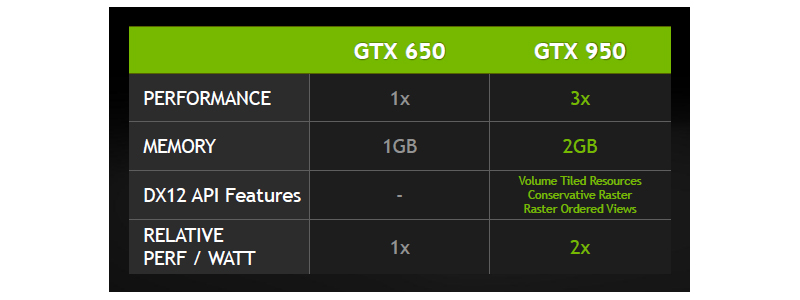
MFAA can be used to provide image quality similar to 4xMSAA, at a cost that’s closer to 2xMSAA. Nvidia’s G-Sync display technology delivers the smooth and fast gaming experience for gamers, free from screen tearing, VSync input lag, and display-induced stuttering (similar to what you can have with FreeSync on AMD graphics cards).
Both Nvidia and AMD are building an ecosystem around their GPUs that’s meant to provide the users with more than just advanced gaming features. Nvidia's policies are offer the most advanced technology for their users, provide the best gaming experiences, and deliver more ways to play than anywhere else.
With the Geforce Experience, gamers don’t have to sort through the myriad of graphics settings many games ship with. With the click of a button, Geforce Experience automatically decides the right game settings for over 250 top games to deliver best performance for your particular GPU.
We think this is a good feature especially for the owners of a GTX 950 and similar graphics cards which are not powerful enough to play games at all different graphics detail levels.
ShadowPlay allows gamers to share their favourite gaming moments with the world. You can record at up to 4K resolution at 60 fps, and even broadcast directly to Twitch. With Nvidia GameStream technology, Geforce GTX gamers can stream games from their PC to their Shield device.
And new Geforce Experience features launching with the GTX 950 mean that there are more ways for gamers to play with their friends.
GameStream Co-Op allows gamers to stream their games over the internet to a friend and play with them cooperatively. You can invite friends to join the game by either sending them an email invite, or copying and pasting an invite URL into a chat program.
You need a Chrome web browser for this to work. It supports DirectX 9 or higher games running in fullscreen exclusive mode. Nvidia recommends at least 7Mbps upstream and downstream for both the host and guest PCs respectively.
To make the recording and broadcasting functions more accessible to Geforce Experience users, the new version of the software integrates a new in-game share overlay menu. With a press of a hotkey (Alt+Z), users can launch the new in-game overlay.

The Packaging
The box is pretty nice. It is not too big, it's just the right size.
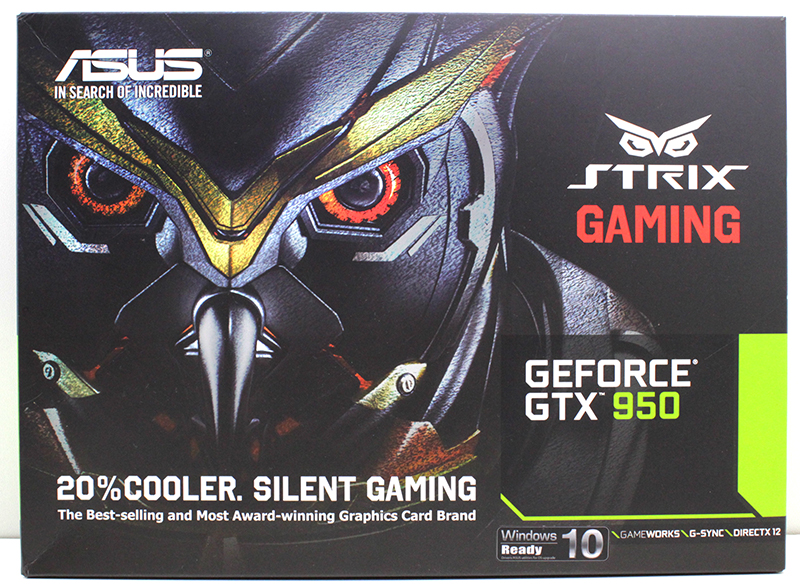
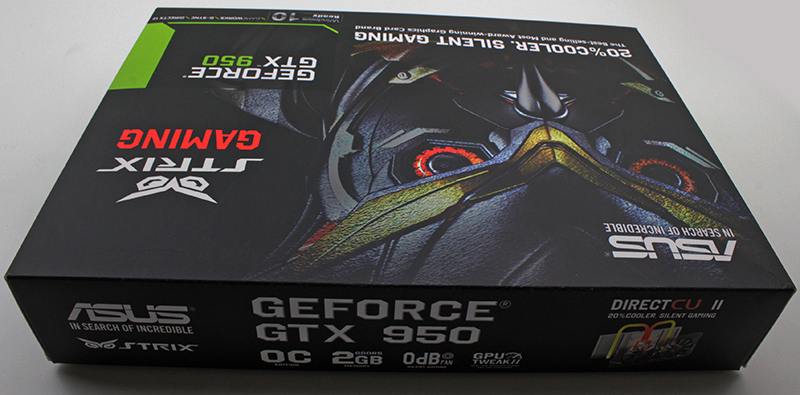
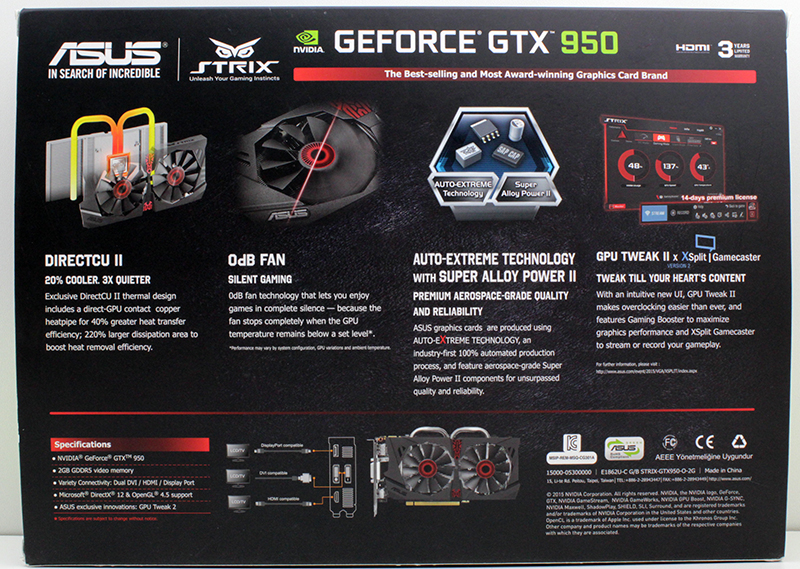
In the box you’ll find:
- Documentation + driver CD
- Strix sticker
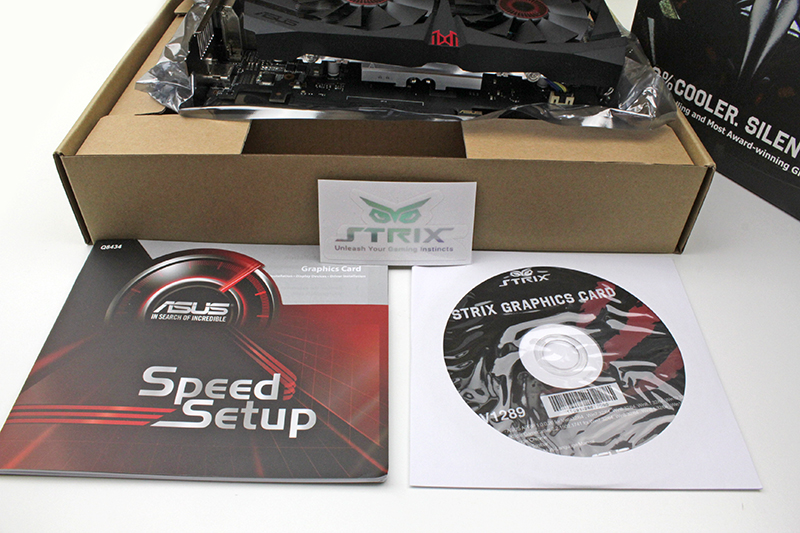
A closer look at ASUS Strix
The dual-slot Strix cooler with DIRECTCU II looks like it should have no trouble keeping the temperatures and noise emissions in check despite a factory overclock.
The GTX 950 Strix comes with 141MHz GPU overclock, but the GM206 GPU is small chip and it has only 90W TDP. And yes, the Strix cooler has cooling capability of up to 175W. The PCB measures 210mm in length while the card with the cooler is 220mm.
We’re talking about a dual-slot cooler with two 7.5cm fans on top. ASUS took an open shroud approach, where fans are positioned on top and blow directly at the heatsink. This means that hot air will not be vented from the chassis. Satisfactory airflow ensures the best possible cooling, but it’s nothing that a few quality intake and outtake fans won’t effectively nullify.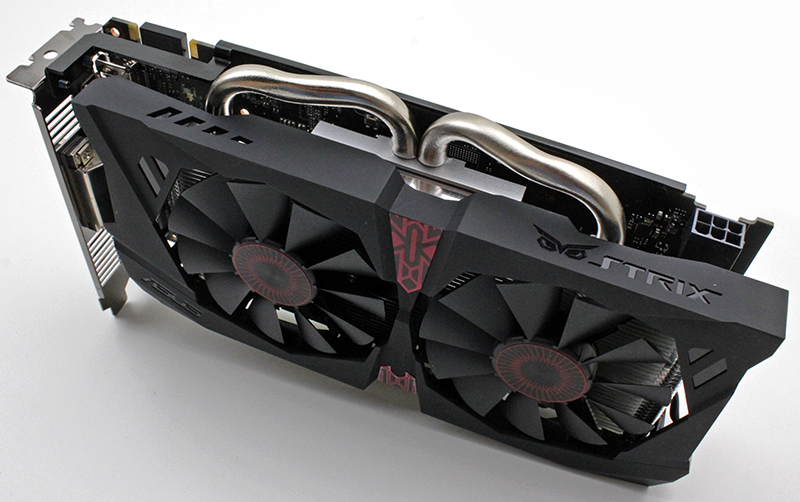
All the juice the card needs can be supplied via the PCIe connector (up to 75W) and a single 6-pin power connector (up to 75W). The reference design sets TDP at 90W. Removing power cable from the header is easy thanks to the cut-out in the PCB, and the fact that the header is placed reversed.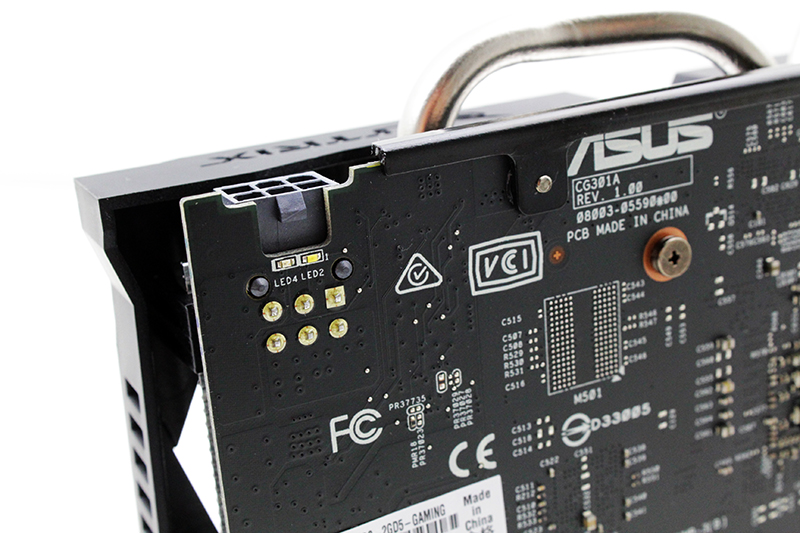
An LED light that will warn you if you forget to use a 6-pin power connector. After the cable is connected the light changes from red to white.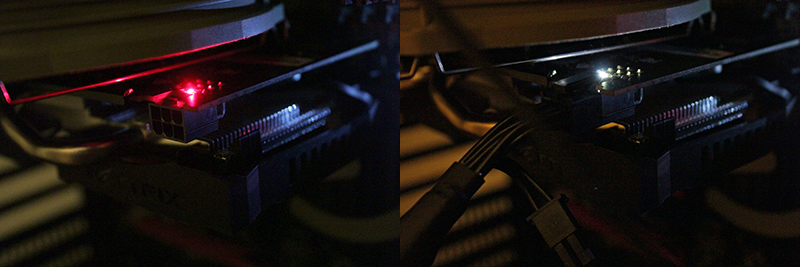
While it is not a high-end product, Nvidia still enabled SLI support on the GTX 950. With the GTX 750 Ti and GTX 650 Ti SLI this was impossible but it was supported on the GTX 650 Ti boost.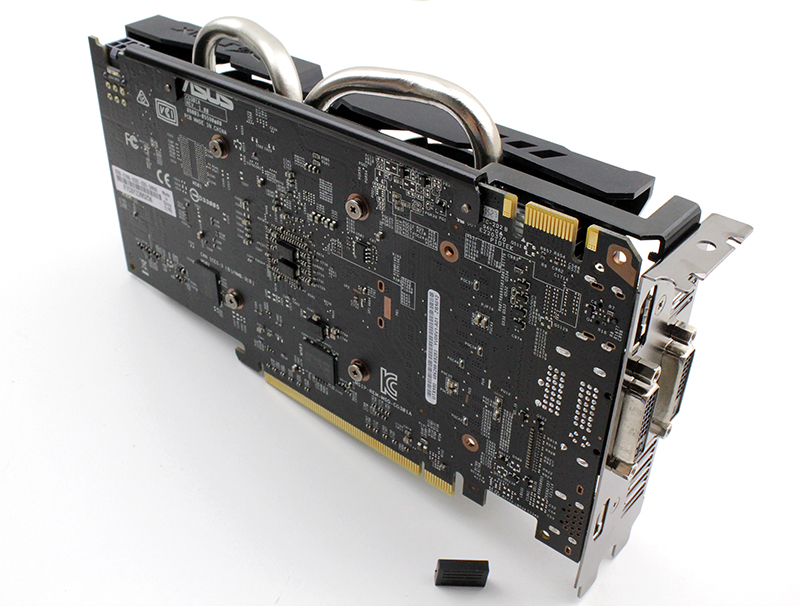
The GTX 950’s display engine supports up to four simultaneous displays at up to 5K (5120x3200) resolution or five physical displays in total.
Display outputs include dual-link DVI, HDMI and DisplayPort connectors, with the number varying depending on Nvidia board partners. ASUS GTX 950 Strix OC comes with two dual-link DVIs, one HDMI and one DisplayPort connector.
With support for HDMI 2.0, the Geforce GTX 950 can playback 4K content at 60 fps and it natively supports H.265 (HEVC) encode and decode in hardware.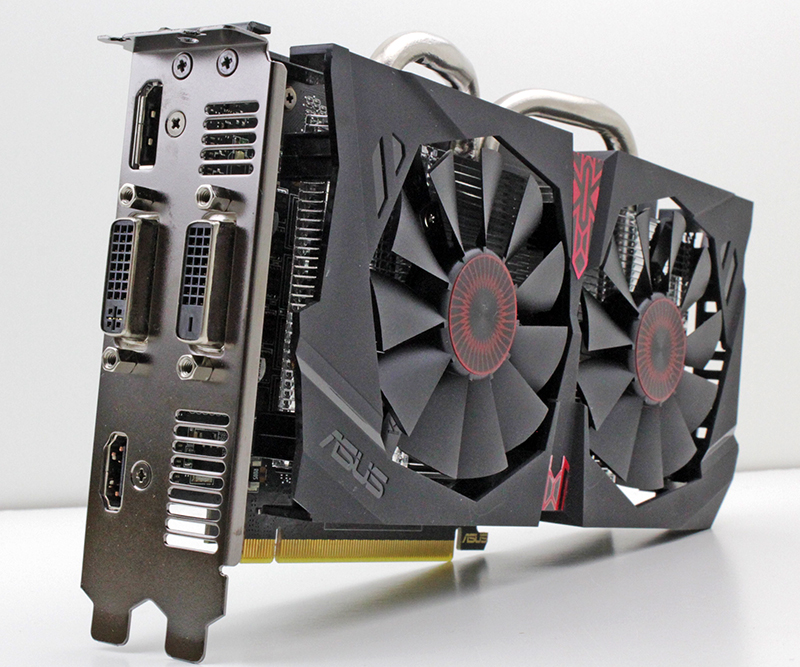
The card has 2GB of GDDR5 memory, courtesy of Samsung. The chip designation is K4G41325FC-HC28. Two of four memory modules are placed on the back side of the PCB. The same memory chips are used on some GTX 970 and GTX 960 cards. They are specified to run at 1750 MHz (7000 MHz GDDR5 effective) but Nvidia lowered the clock to 1650MHz for the GTX 950.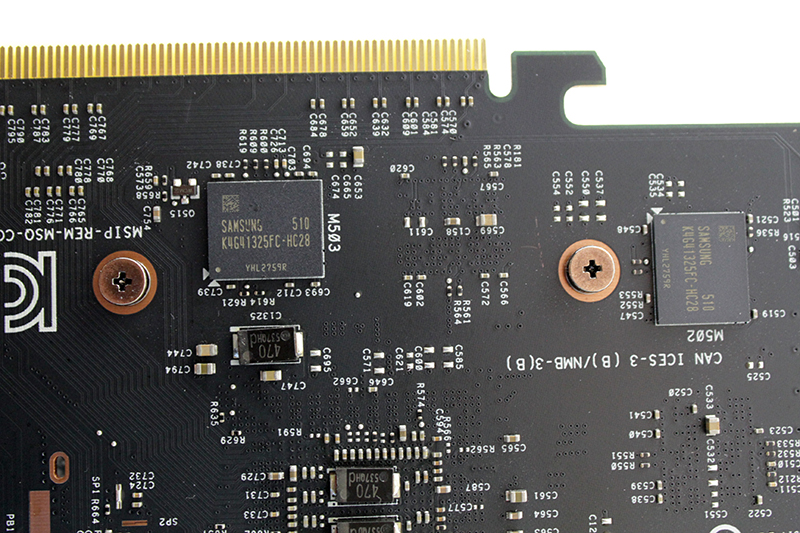
The cooler on the GTX 950 Strix OC only deals with heat dissipation from the GPU, while memory and power components are cooled indirectly by airflow.
The whole cooler is held only by four screws in vicinity of the GPU but there are no vibrations or signs of instability. Next image shows the GTX 950 Strix OC card with the cooler removed.
Strix cooler is relatively heavy for the small PCB and to ensure stability ASUS implemented one metal bar along the top edge to stabilize the card.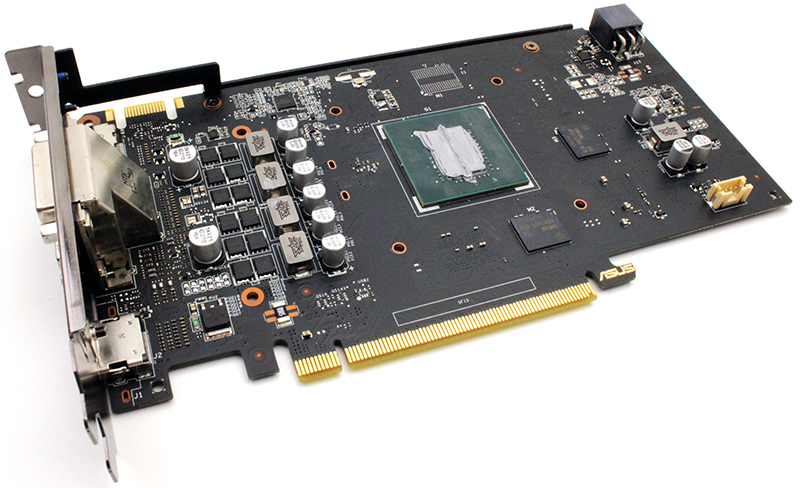
Strix cooler does not come with a copper base. Instead it uses so called DirectCU II thermal design. This is a direct-GPU contact with heatpipes. This way a copper heatpipes transfer heat faster from the GPU to the heatsink. According to ASUS internal testing, the DIRECTCU II offer 20 per cent better cooling and the card is three times quieter compared to the Nvidia reference design.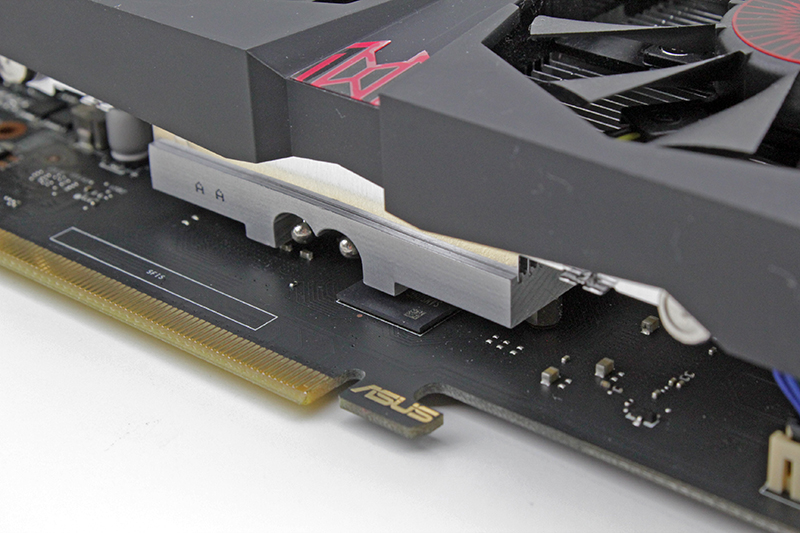
Testbed
Recently we migrated to new Windows 10. We apologise for not including some other cards, especially competing card from AMD in the result tables. We are working hard to update all table results.
Migration was not straightforward and without issues. We tried the windows upgrade and ended-up with some bugs related to Nvidia driver. The Nvidia driver was not shown in Control Panel among other installed programs, however Nvidia Control Panel was accessible and fully working. This issue was solved with an Nvidia driver reinstall.
We could not find a solution for the second, more serious problem. We were not allowed to rise the graphics card memory clock but the GPU overclocked without problems. This issue was present when we upgraded from Windows 8.1 to Windows 10.
A fresh install solved above mentioned problems. We believe that most of our readers will do fresh OS install however, and we advise you to do so.
Windows upgrade may work for the most users, but there is no warranty that every byte will at the right position after upgrade.
Testbed:
- Motherboard: EVGA X99 FTW
- CPU: Intel Core i7 5960K, 4.2GHz (Haswell-E)
- CPU Cooler: Thermalright HR-02
- Memory: 4x4GB Kingston HyperX Predator DDR4 memory Review (HX430C15PBK4/16)
- SSD: Toshiba THNSNJ256GCSU 256GB
- Case: CoolerMaster Cosmos II
- Operating System: Win10 64-bit
Drivers:
- Nvidia 353.62
- Nvidia 355.65
3DMark
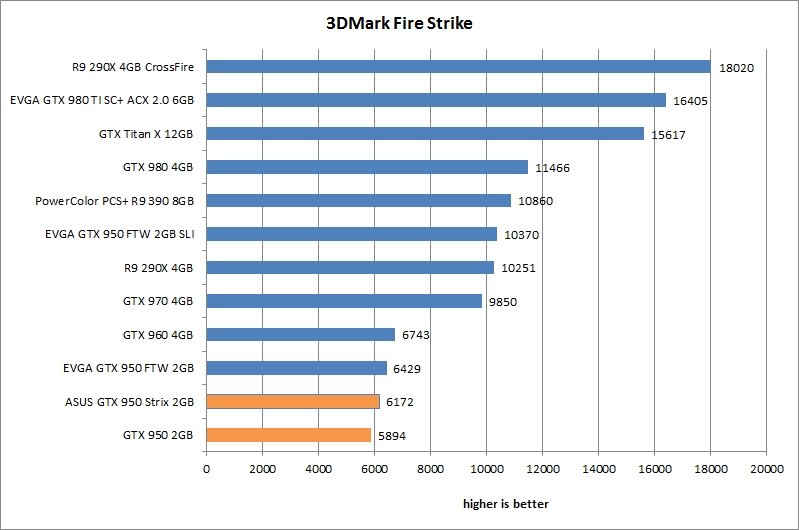
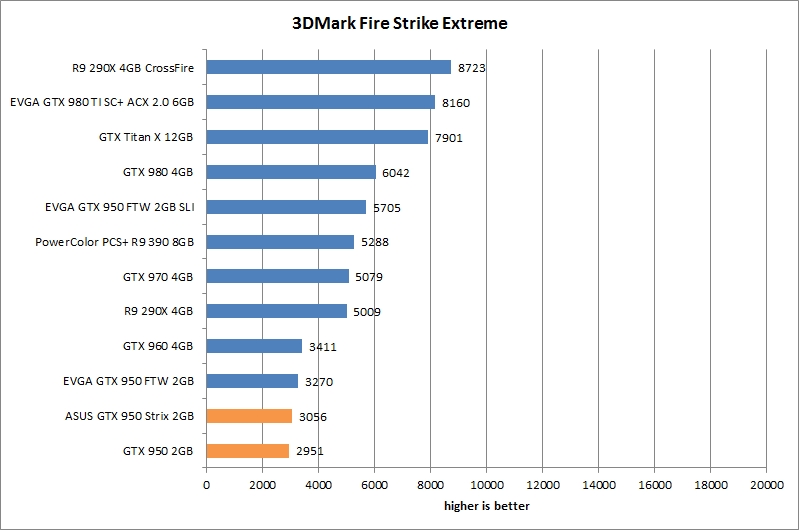
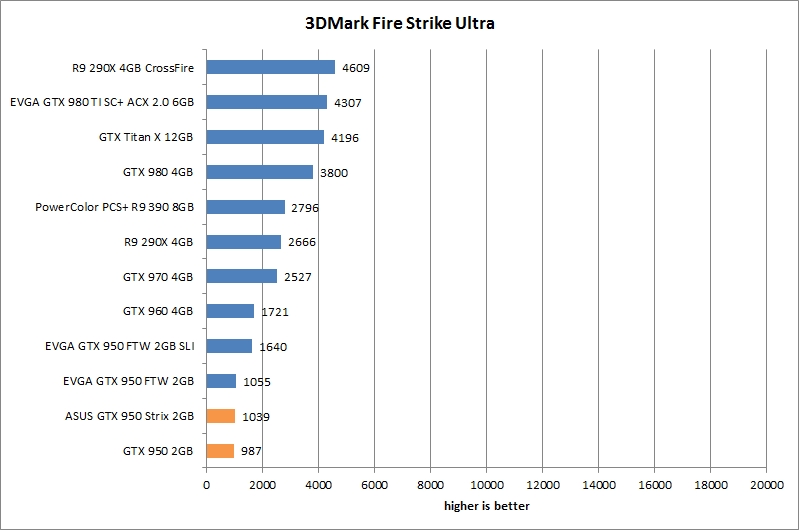
Unigine Heaven
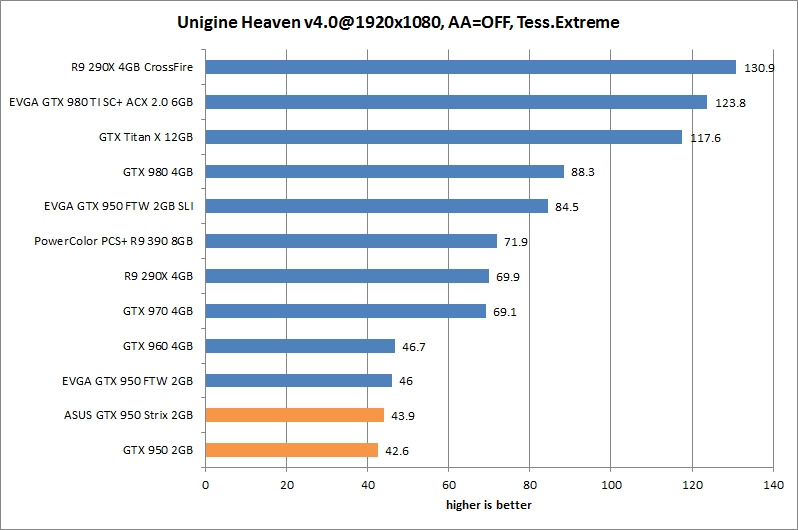
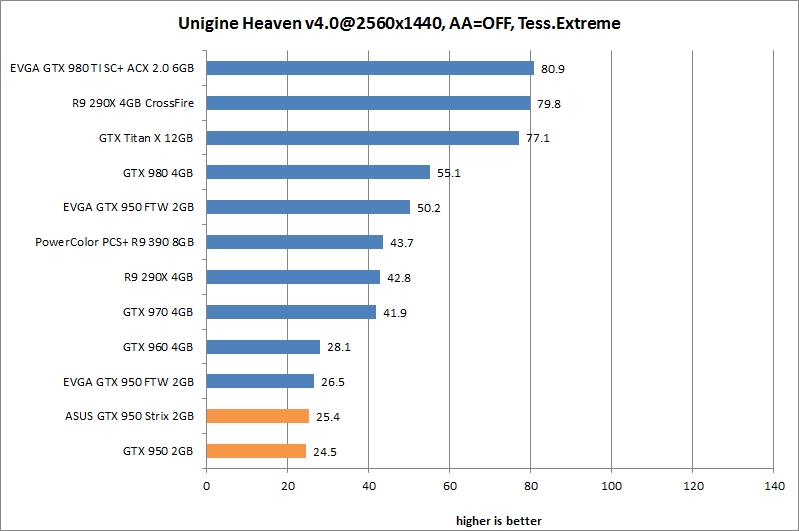

BioShock Infinite
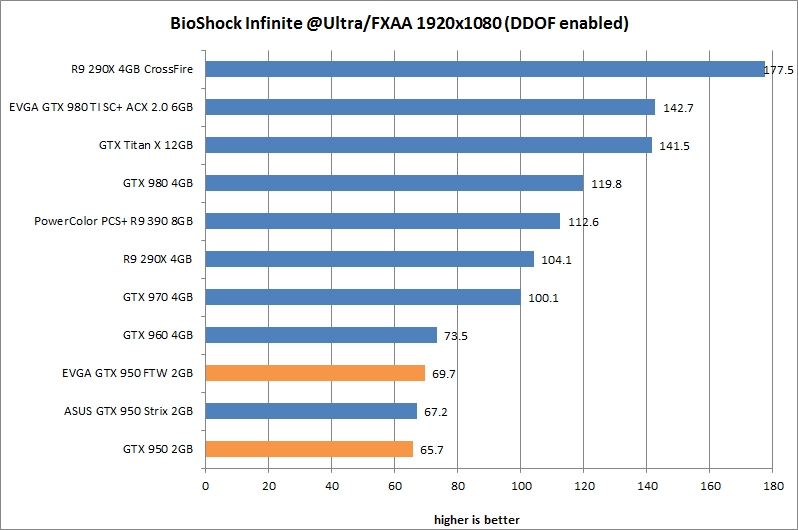
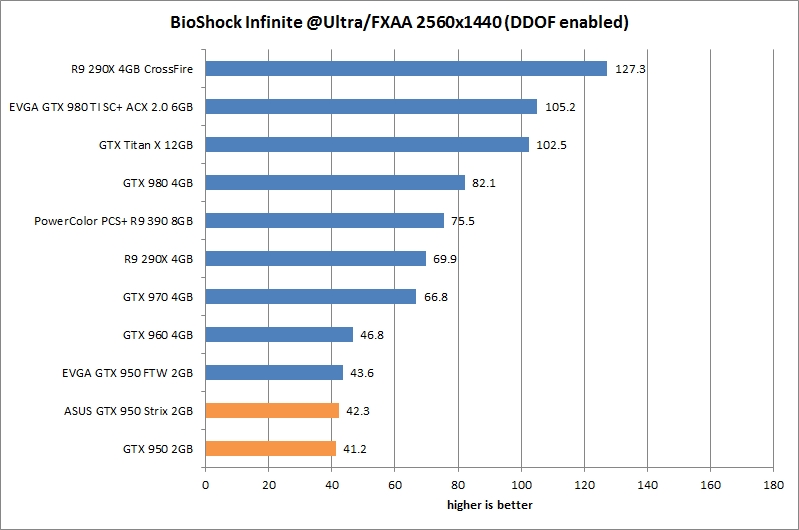
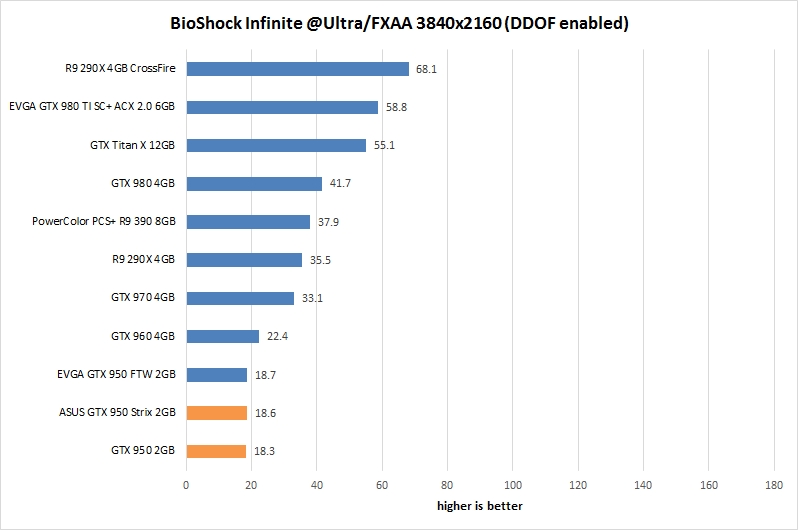
Tomb Raider
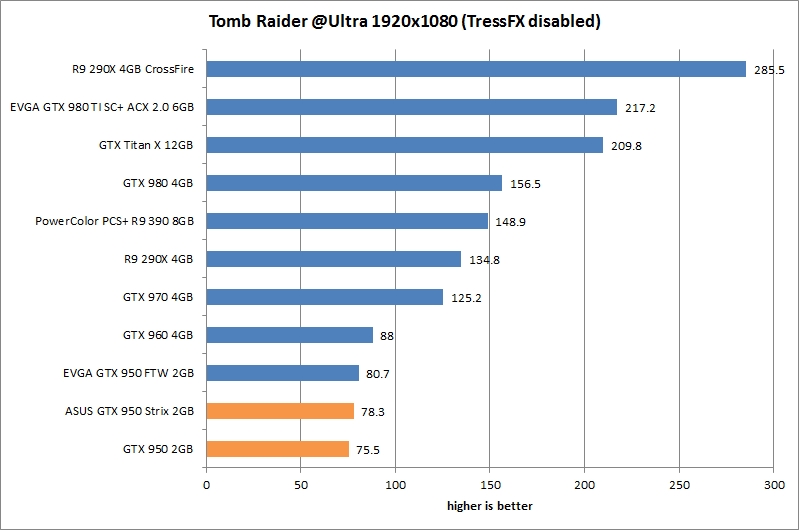
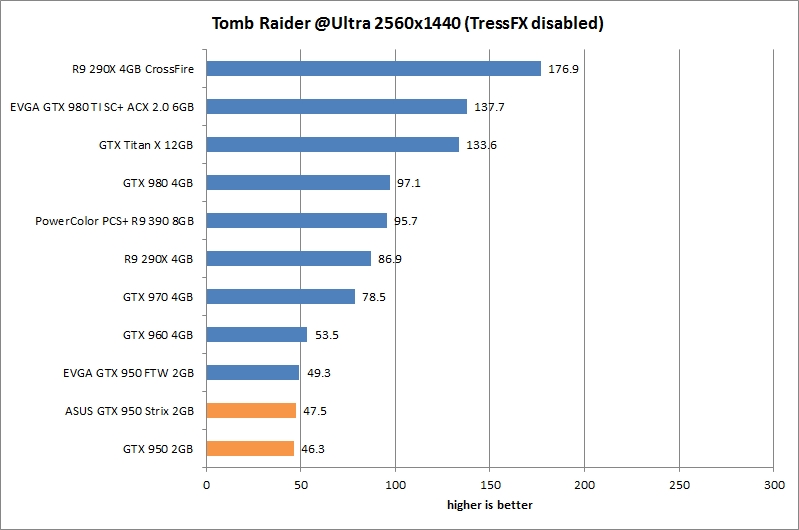
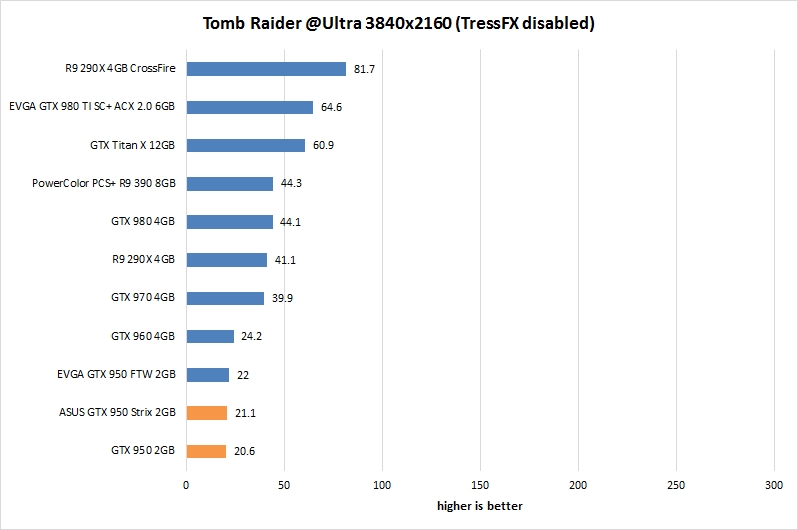
Thief
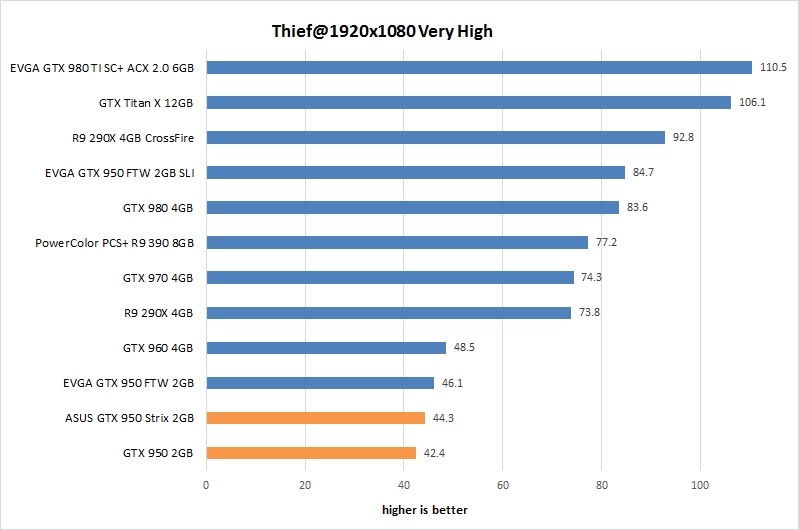
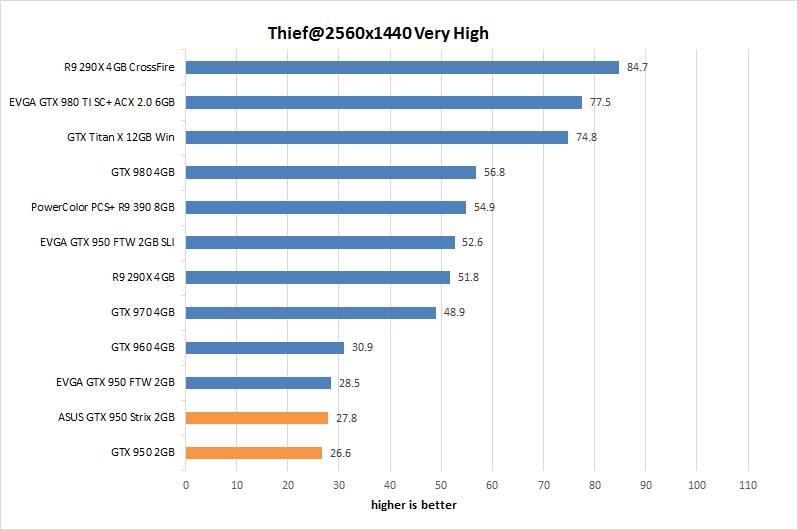
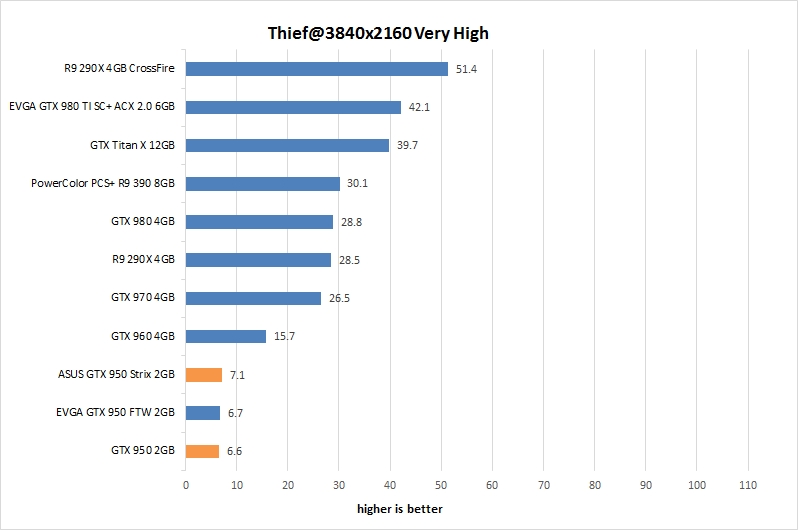
The Witcher 3
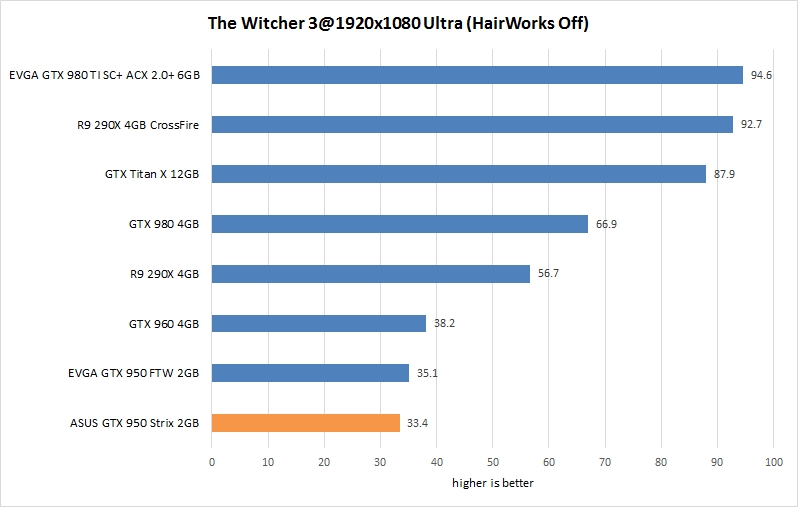
Battlefield 4
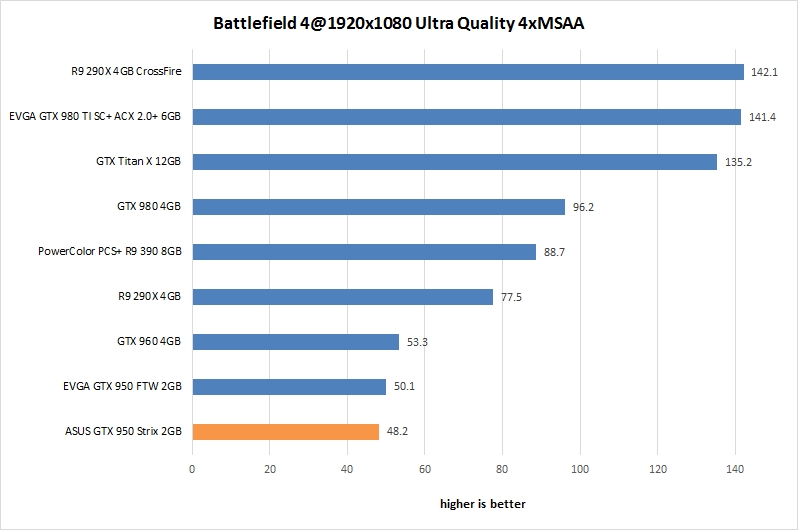
Crysis 3
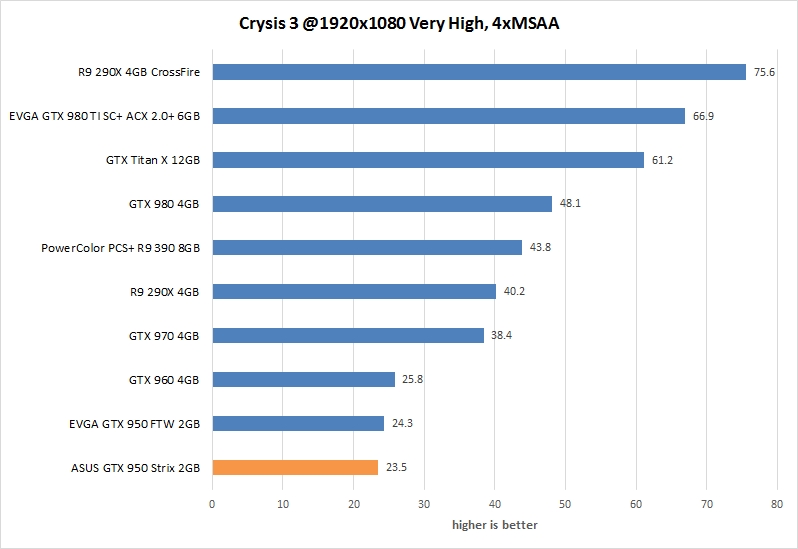
Thermals and Noise
The GTX 950 Strix OC is a factory overclocked card with bumped up GPU frequencies, yet thanks to the advanced cooler it is supposed to be cool and quiet.
Indeed the GTX 950 Strix OC fans were almost inaudible in 3D and this time we can confirm there is no coil whine. We expected to see good cooling performances since the used cooler has capability of up to 175W. The card has TDP of only 90W so it does not even need all that cooling for proper work.
The card is silent in idle and during media playback or light gaming. Namely the card turns its fans off when GPU temperature is below 60 degrees Celsius. The screenshot below shows this works in practice. Note how fan RPM reaches zero before the fans are stopped, but this is normal since the fans can not stop rotate immediately.
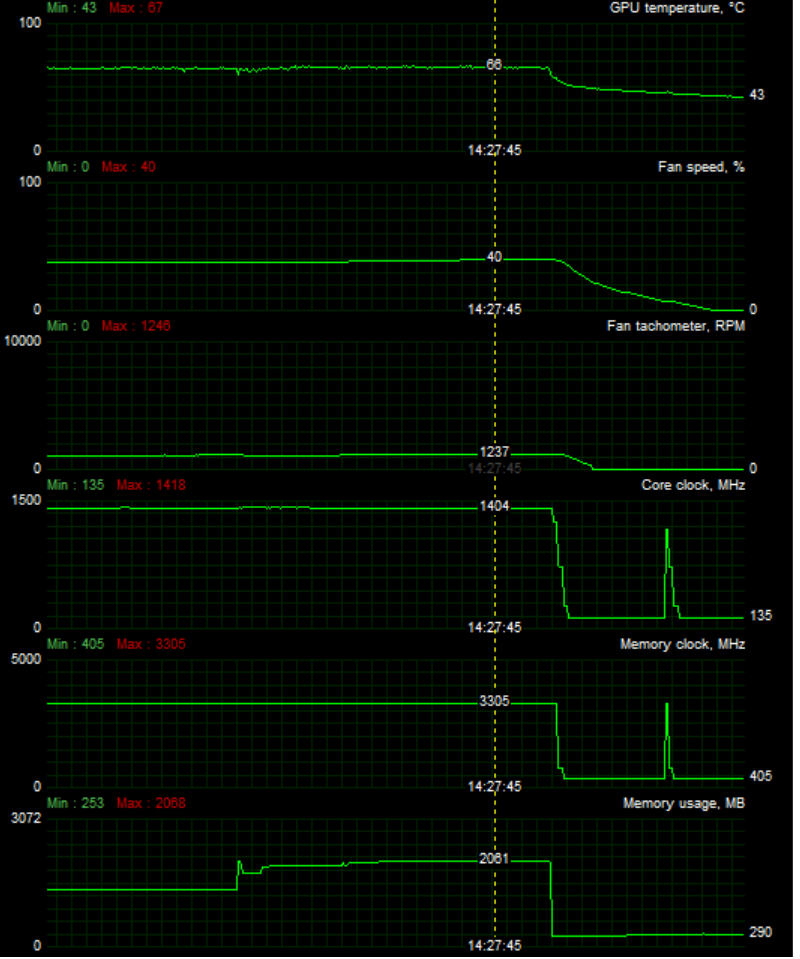
Power Consumption
The GTX 980, GTX 970, GTX 960 and GTX 950 do not bring a huge performance boost compared to the previous generation, but they prove Maxwell is vastly more efficient than Kepler, at least in high end segment. The GTX 980 has a TDP of just 165W, GTX 970 has a TDP of just 145W, GTX 960 has TDP of just 120W and GTX 950 has TDP of 90W.
While it might have more CUDA cores, higher GPU clocks and faster memory compared to the GTX 750 Ti, the Geforce GTX 950 has a higher 90W TDP, compared to 60W on the GTX 750 Ti. This means that some HTPC users will be unhappy to hear that it needs a single 6-pin PCI-Express power connector.
ASUS GTX 950 Strix OC card is factory overclocked (141MHz for the GPU) and this increases power consumption. We do not have reference card so we don’t know the exact difference in real life conditions, but we compared it to the EVGA GTX 950 FTW.
Playing games at 1080p resolution makes no big difference in power consumption between the two GTX 950 cards. In some games we measured less in other more power consumption. When we switched to 1440p and 4K resolution, which is however not a target resolution for the GTX 950, we measured a couple of watts more for the EVGA GTX 950 FTW card, probably due to its higher clocks.
Compared to the GTX 960 which consumes at maximum about 129W, the GTX 950 Strix card consumes about 10W to 15W less.
Overclocking
The Geforce GTX 950 has a fair amount of overclocking headroom. But each sample overclocks differently and our results can serve only as guideline for what you can achieve with another GTX 950.
The reference card’s base clock frequency is 1024MHz, with a boost clock of 1188MHz. However, the ASUS GTX 950 Strix OC base clock frequency is 1165MHz, with a boost clock of 1355MHz, and we measured clocks up to 1418MHz in games. This is already 141MHz overclock for the Base GPU clock but we achieved +110MHz over the GPU factory overclock. This was achieved by using standard voltage and AUTO fan settings.
Memory overclocking was good and we raised memory clock by 350MHz (1400MHz effective GDDR5). Overall we measured up to 14 per cent performance increase after our overclocking.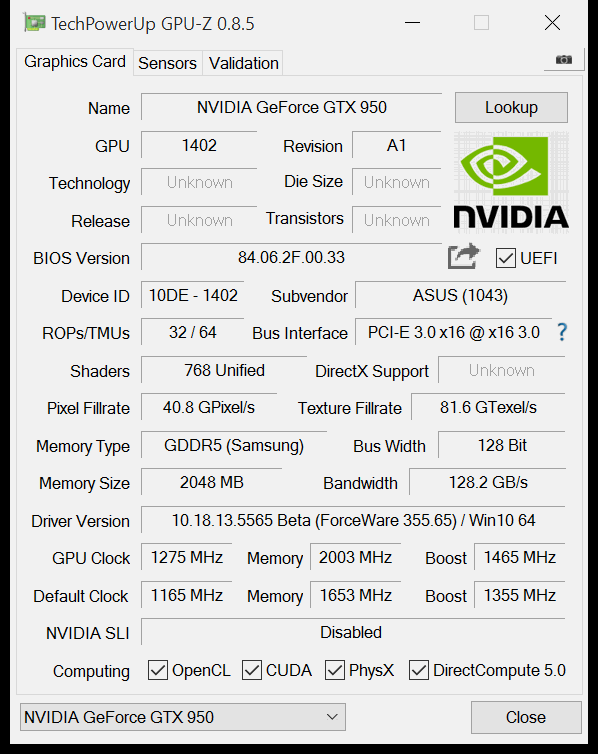
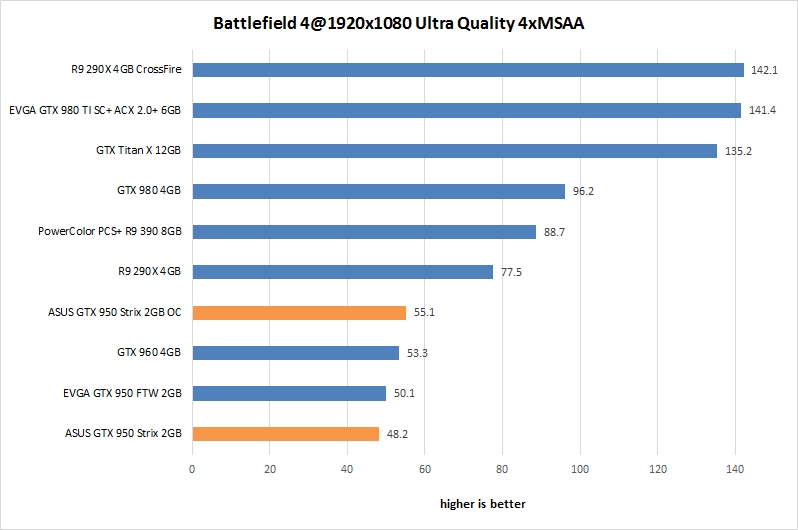
Conclusion
With Geforce GTX 950 graphics card, Nvidia brings the new Maxwell architecture enabled features for gamers on budget. At least we hoped it will be that way. The suggested MSRP including VAT for the GTX 950 is €169 (Germany) while in most other EU countries the prices starts from 179€. This is more than we expected considering the card’s name. Traditionally GTX 750/650/550 series was cheaper, for example the GTX 750 Ti was priced at €140.
The card has power to play many games with high in-game details at 1920x1080 resolution and that is important. You should consider this card if you are upgrading from an older entry level GPU, like GTX 650 for example.
The Geforce GTX 950 will even deliver playable frame rates with 4K DSR when playing MOBA games like League of Legends.
The GTX 950 comes with DirectX 12 support and good power efficiency. Many other features are supported like ShadowPlay and GameStream Co-Op which allows gamers to share their favourite gaming moments with the world or with a friends and play with them cooperatively.
ASUS GTX 950 Strix OC graphics card comes with a good 141MHz factory overclock which translates into upt to 5 per cent performance bump right out of the box. The Strix cooler is almost inaudible in 3D while the card turns its fans off when GPU temperature is below 60 degrees Celsius. This means total silence while watching movies or web surfing.
The GTX 950 Strix OC is priced about €20 more than the cheapest GTX 950. In this price range this is considerable price difference but still we recommend the Strix OC card if you want top performing GTX 950 card with silent cooler. Also it provides great overclocking which can give you up to 12 per cent performance increase.

